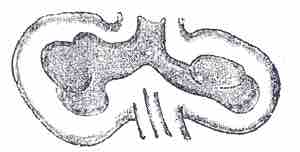The respiratory system lies dormant in the human fetus during pregnancy. The development of the lungs can be divided into different stages. The pseudoglandular period (also known as "glandular period") spans weeks six to 16 and during this time the developing lung resembles an endocrine gland. By the end of this period, all of the major lung elements, except those required for gas exchange (e.g. alveoli), have appeared. Respiration is not possible during this phase and fetuses born during this period are unable to survive. The canalicular period spans weeks 16 to 26 and during this time the lumens of the bronchi enlarge, lung tissue becomes highly vascularized, and respiratory bronchioles and alveolar ducts develop from the terminal bronchioles. Respiration is possible towards the end of this period, but few fetuses born during this time will survive. The terminal saccular period spans from week 26 to birth. During this time, the important blood-air barrier is established.
Specialized cells of the respiratory epithelium appear including type II alveolar cells which secrete pulmonary surfactant. This surfactant is important in reducing the surface tension at the air-alveolar surface, allowing expansion of the terminal saccules. During this time, the lungs are rock-like and will sink if placed in water but will expand after the first breath, a trait which is used to determine if babies were born alive. Figure 1 shows the right and left lung buds from which the bronchi and lungs will develop. At birth, the respiratory system becomes fully functional upon exposure to air, although some lung development and growth continues throughout childhood. Pre-term birth can lead to infants with under-developed alveolar type II cells which produce surfactant. The lungs of pre-term infants therefore may not function well because the lack of surfactant leads to increased surface tension within the alveoli leading to alveoli collapse and no gas exchange, a condition known as respiratory distress syndrome. Lastly, the alveolar period spans from birth to eight years of age and during this stage the terminal saccules, alveolar ducts, and alveoli increase in number. True alveoli appear as indentations in the saccular wall and septae form to produce divisions in the wall.

Respiratory buds
Lung buds from a human embryo of about four weeks, showing commencing lobulations.